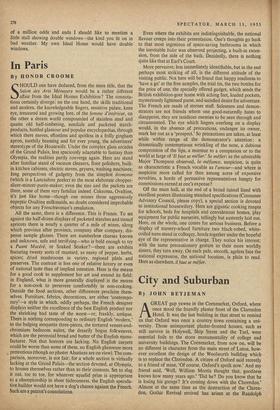In Paris By HONOR CROOME S HOULD one have deduced, from
the mere title, that the Salon des Arts Menagers would be a rather different affair from the Ideal Homes Exhibition? The connota- tions certainly diverge; on the one hand, the skills traditional and modern, the knowledgeable fingers, sensitive palate, keen eye, treasured and growing lore, of the femme d'interieur, on the other a dream world compounded of stainless steel and quaint old half-timbering, sundials and packeted starch- products, bottled glamour and 'popular encyclopmdias, through which there moves, effortless and spotless in a frilly gingham apron, toothily beaming and for ever young, the advertisers' stereotype of the Housewife. Under the complex glass arcades of the Grand Palais, less spaciously adaptable to fantasy than Olympia, the realities partly converge again. Here are stand after familiar stand of vacuum cleaners, floor polishers, built- in kitchen cabinets, electric stoves, geysers, washing machines; long perspectives of gadgetry from the simplest econome (which is a Lancashire peeler) to the most elaborate chopper- slicer-mincer-purée-maker; even the tins and the packets are there, some of them very familiar indeed. Cakeoma, Ovaltine, it's just like home—though one misses those aggressively eupeptic Ova!tine milkmaids, no doubt considered improbable objects for any FrenchWoman's emulation.
All the same, there is a difference. This is France. To set against the half-dozen displays of packeted starches and tinned apricots there is nearly a quarter of a mile of wines, along which province after province, company after company, dis- pense sample glasses. There are numberless cheeses known and unknown, safe and terrifying—who is bold enough to try a Puant Macere, or Soaked Stinker?—there are exhibits featuring twenty sorts of mustard, as many of pepper, herbs, spices; dried mushrooms in variety, regional pâtés and preserves. The contrast is less one of relative luxury or even of national taste than of implied intention. Here is the means for a good cook to supplement her art and extend its field; in England, what is more generally displayed is the means for a non-cook to persevere comfortably in non-cooking. Outside the food sections, other differences proclaim them- selves. Furniture, fabrics, decorations, are either 'contempo- rary'—a style in which, oddly perhaps. the French designer displays neither the excellence of the best English product nor the shrieking bad taste of the worst—or, frankly, antique. There is nothing corresponding to ordinary English 'modern.' to the bulging moquette three-pieces, the tortured veneer-and- chromium bedroom suites, the drearily bogus folkweaves, which are the perennial bread and butter of the English manu- facturer. Not that horrors are lacking. No English carpets could be worse than some of these, no English glassware more pretentious (though no plaster Alsatians are on view). The com- parison, moreover, is not fair; for a whole section is virtually lacking at the Grand Palais—the section devoted, at Olympia, to houses themselves rather than to their contents. Set to slug it out, toe to toe, for whatever squalid prize is appropriate to a championship in sheer hideousness, the English specula- tive builder would not have a dog's chance against the French. Such are a patriot's consolations. , Even where the exhibits are indistinguishable, the national flavour creeps into their presentation. One's thoughts go back to that most ingenious of space-saving bathrooms in which the inevitable bidet was observed projecting, a built-in exten- sion, from the side of the bath. Decidedly, there is nothing quite like that at Earl's Court.
More pervasive, less immediately identifiable, but in the end perhaps most striking of all, is the different attitude of the visiting public. Not here will be found that happy readiness to 'have a go' at the free samples, the trial tin, the two bottles for the price of one, the specially offered gadget, which sends the British exhibition-goer home with aching feet, loaded pockets. mysteriously lightened purse, and satisfied desire for adventure. The French are made of sterner stuff. Salesmen and demon- strators are not friends whom one good-naturedly hates to disappoint, they are insidious enemies to be seen through and circumvented. The eye which lingers overlong on a display would, in the absence of precautions, endanger its owner, mark her out as a 'prospect.' So precautions are taken, at least while within range of the demonstrator's attention : a dramatically contemptuous wrinkling of the nose, a dubious compression of the lips, a murmur to a companion or to the world at large of '11 faut se mefier.' Se mefier; as the admirable Major Thompson observed, la mefiance, suspicion, is quite as characteristic a French vocable as l'amour—and where is suspicion more called for than among acres of expensive novelties, a horde of persuasive representatives hungry for commissions earned at one's expense?
Off the main hall, at the end of a broad tunnel lined with excellent posters illustrating standard specifications (Consumer Advisory Council, please copy), a special section is devoted to institutional housewifery. Here are gigantic cooking ranges for schools, beds for hospitals and convalescent homes, play equipment for public nurseries, tellingly but austerely laid out.
Here, on the whole, one comes for serious business. Before a display of nursery-school furniture two black-robed, white- coifed nuns stand in colloquy, heads together under the hopeful eye of the representative in charge. They notice his interest; with the same precautionary gesture as their more worldly sisters, they turn away. On each pale, smooth, ageless face the national expression, the national locution, is plain to read. Here as elsewhere, il faut se mefier.










































 Previous page
Previous page